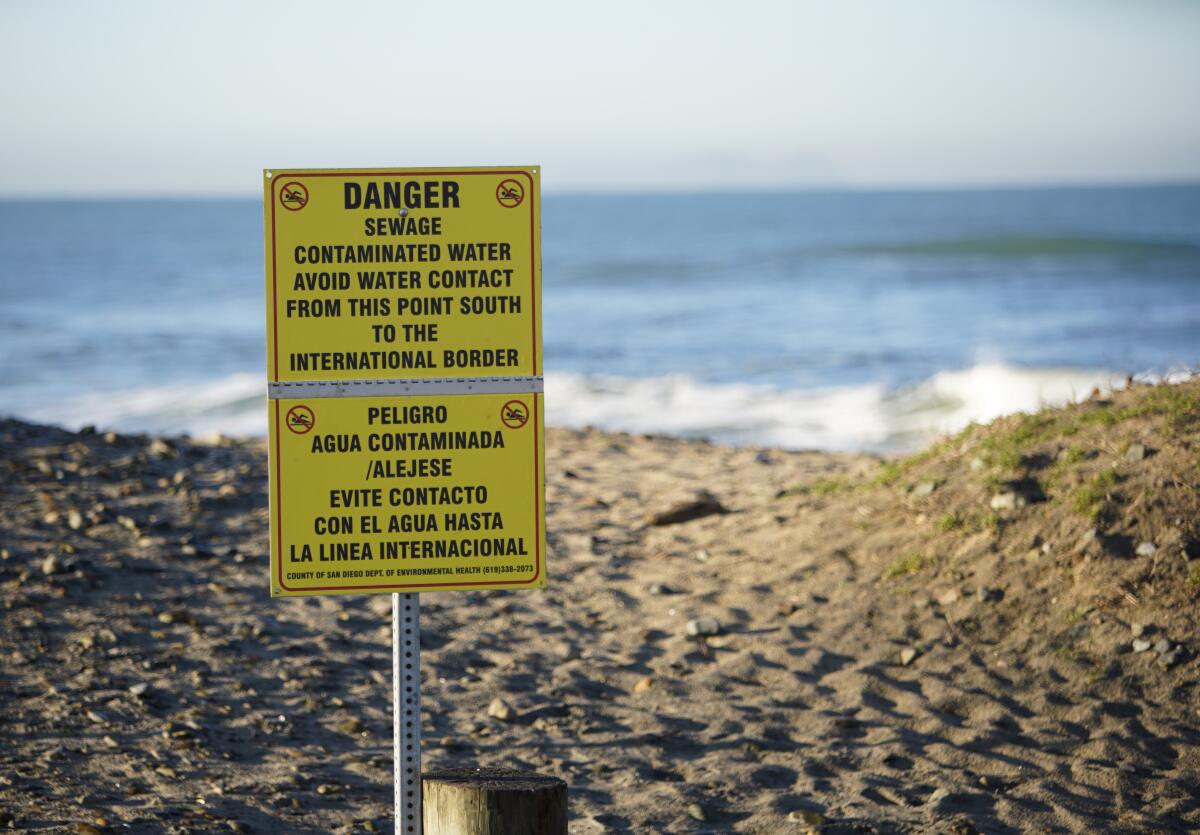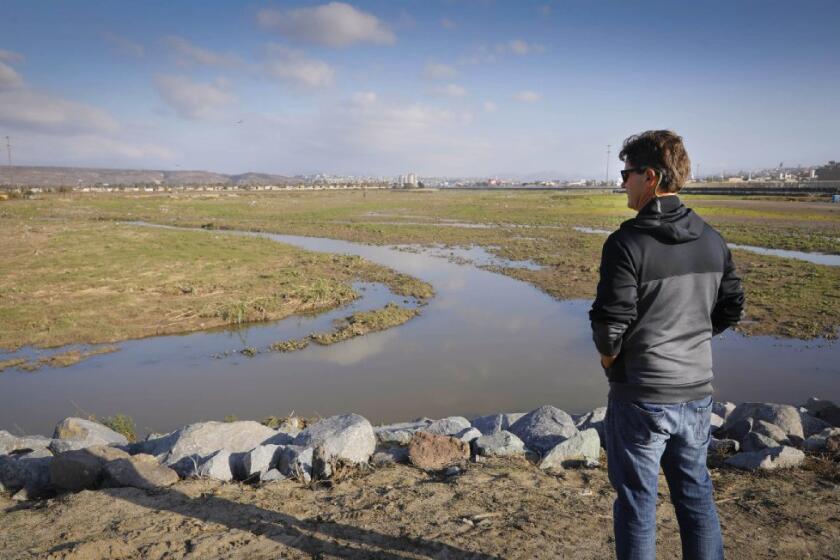EPA outlines $630-million plan to curtail Tijuana sewage pollution in San Diego

- Share via
Top federal environmental regulators in California laid out a $630-million plan on Monday to capture and treat sewage-tainted water that routinely flows over the border from Tijuana into Imperial Beach and up the coast.
The blueprint focuses largely on installing a pumping system in the Tijuana River north of the U.S.-Mexico border to suck polluted flows out of the channel before they can foul shorelines in San Diego. Trash booms would be installed directly upstream of the intake.
The U.S. Environmental Protection Agency hopes to break ground on the project by 2023. The upgrades would also include building a facility to treat the diverted river water from not only the new pumping station but an existing facility in the river operated by Mexico just south of the border.
“I am grateful to the U.S. EPA for supporting the development of a comprehensive solution to fix the U.S.-Mexico border water pollution crisis,” said Imperial Beach Mayor Serge Dedina, whose city’s southern shoreline has been closed for 218 days this year due to pollution from Mexico.
The EPA has secured roughly $300 million in federal funding to help realize the binational vision, which also includes more than doubling the capacity of the South Bay International Wastewater Treatment Plant at the border to treat more sewage and polluted runoff coming from Tijuana.
Officials said they hope the plan, which could reduce beach closures by 95% during the spring and summer, can be completed by 2030. Heavy rains would still flush water over the border into the Tijuana River Estuary, which is important for the ecological health of the system.
“This agency is working as fast as it can,” said Andrew Sawyers, director of the EPA’s Office of Wastewater Management. “This is a regional priority for us to expedite a solution. We hope to see success on the ground fairly soon.”
The Imperial Beach shoreline near the international border was closed for 295 days last year.
Many other high-profile public officials voiced support for the effort Monday, including Rep. Mike Levin (D-San Juan Capistrano), who helped secure the funding as part of an overhaul to the North American Free Trade Agreement early last year.
“Pollution along the Tijuana River Valley has plagued our region for years, harming our environment, public health and our local economy,” he said in a statement. “It’s long past time we stop the flow of this pollution from Mexico for good.”
Large volumes of wastewater are currently discharged directly into the Pacific Ocean in Mexico at a location known as Punta Bandera. Those flows can float up the coast and impact beaches in San Diego.
Tijuana has a treatment facility in the area, known as the San Antonio de los Buenos plant, but it has fallen into disrepair.
The EPA’s plan calls for replacing the wastewater plant in order to better serve Tijuana’s coastal communities and prevent polluted discharges into the sea. A timeline for construction is still uncertain and would likely require sizable investment from Mexico.
Still, changes to the region’s wastewater system, including rerouting stormwater capture basins in the canyons along the border, would divert much of that polluted flow to the expanded treatment plant in San Diego.
Imperial Beach, Calif., Mayor Serge Dedina criticized Mexican authorities. Gov. Jaime Bonilla demands a public apology.
Another major change south of the border would include upgrades to Arturo Herrera and La Morita wastewater treatment plants on the east side of the city. These facilities currently discharge treated effluent into the Tijuana River — flows that collect trash and sewage as they head north to the border.
The EPA has called for sending that treated water to the Rodriguez Reservoir or a groundwater basin. That would reduce regular flows in the Tijuana River and lower the likelihood that a sewage spill that empties into the channel could overwhelm the diversion system’s pumping capacity.
“This would be mostly for dry weather, when there’s spills, when there’s an upset in the system,” said Tomás Torres, water division director of EPA’s Pacific Southwest region.
EPA estimates the U.S. could end up paying for about $566 million of the overall plan. Cost-sharing negotiations with Mexico are still ongoing, officials said.
Monday’s announcement comes several years after Imperial Beach sued the federal government for Clean Water Act violations concerning the cross-border pollution. Many local governments and agencies piled on, including then-California Attorney General Xavier Becerra.
“This plan will go a long way to ensuring that the residents of both sides of the border have access to clean water and beaches and is due to in large part to extraordinary leadership at every level in San Diego,” said Dedina, who brought the issue to the forefront after a massive 2017 sewage spill in the Tijuana River.
More to Read
Sign up for Essential California
The most important California stories and recommendations in your inbox every morning.
You may occasionally receive promotional content from the Los Angeles Times.















